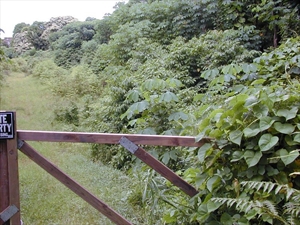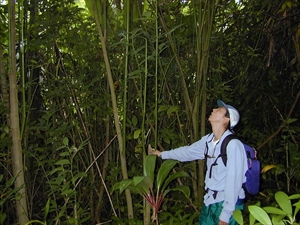- Worldwide distribution. In American Samoa, Cook Islands, Federated States of Micronesia, Fiji, Niue, Northern Mariana Islands, Papua New Guinea, Samoa, Solomon Islands, Tonga, Vanuatu.
- Invasive, aggressive shrub, of logged native forests (preventing regeneration), waterways, roadsides and cultivated lands, e.g., plantations, pastures, fallows, subsistence gardens. High seed production, ability to regenerate vegetatively and grow rapidly under varying rainfall (rainforest to savanna).
- Shrub up to 8m. Stems swollen at nodes, with stilt roots. Leaves alternate, oval, up to 22cm, short leaf stalks, soft hairs underneath, aromatic when crushed. Flowers on curved spike opposite each leaf, on long stalks. Seeds small, up to 1.25mm, black.
- Spread: birds, bats, wind, on clothing, machinery, vehicles, packing materials, as ornamental.; in kava consignments.
- Biosecurity: check seed and kava imports.
- Biocontrol: none.
- Cultural control: hand-weed, removing all roots; or slash and collect cuttings and burn.
- Chemical control: 2,4-D or imazapyr applied to basal bark or cut stems.
Pacific Pests, Pathogens and Weeds - Online edition
Pacific Pests, Pathogens, Weeds & Pesticides
Spiked pepper (493)
Spiked pepper. It is also known as bamboo piper, yaqona ni (Fiji), and false kava (note, this is also the name given to Piper auritum (see Fact Sheet no. 492).
Piper aduncum. It is a member of the Piperaceae.
AUTHOR Grahame Jackson
Information from CABI (2019) Piper aduncum. Invasive Species Compendium. (https://www.cabi.org/isc/datasheet/41354); and Piper aduncum L. (2020) Weeds Australia - Profiles. Centre for Invasive Solutions, Department of Agriculture, Water and the Environment. Australian Government. (https://profiles.ala.org.au/opus/weeds-australia/profile/Piper%20aduncum); and from Piper aduncum L., Piperaceae (2011) Pacific Islands Ecosystems at Risk (PIER). (http://www.hear.org/pier/species/piper_aduncum.htm). Photos 1-4 Forest & Kim Starr. Piper aduncum (Spiked pepper).
Produced with support from the Australian Centre for International Agricultural Research under project HORT/2016/185: Responding to emerging pest and disease threats to horticulture in the Pacific islands, implemented by the University of Queensland and the Secretariat of the Pacific Community.







